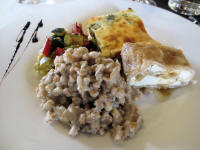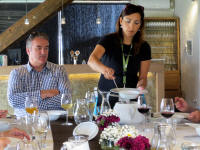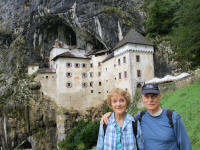

Click on any picture below to see a larger version
September 11, 2017 - Škocjan Caves and Predjama Castle
Today we visited two of Slovenia's most famous sites, the Škocjan Caves and Predjama Castle.
Since it rained most of the day, it was ideal for a cave visit. The Škocjan Caves system
(UNESCO world heritage site) comprises numerous caves and passages, collapse dolines,
natural bridges and sinkholes. It was created by the Reka River, which flows some 50km
on the surface then sinks into the karst underground, resurfacing again at Timavo springs
near the Gulf of Trieste (where we hiked a few days ago). Photos weren't allowed in the cave
but the camera might have gone off accidentally a couple of times.
Archaeological research has shown that people lived in the caves and the surrounding area
in prehistoric times (from the Mesolithic, the Neolithic, the Bronze and Iron Ages through
Antiquity and the Middle Ages to the present — that makes more than 5,000 years!).
ABOVE - Photos weren't allowed in the cave but the camera might have gone off
accidentally a couple of times. Stalactites, stalagmites and columns in one of the caverns.
The tour hike was about 2 miles long, goes up and down 500 steps and lasted two hours.
A good place to spend a rainy morning!
ABOVE LEFT - This pic is in the "Murmuring Water Cave", named because of the river
roaring through the bottom. Fred is the shadowy figure on the left getting ready
to cross the footbridge 150 feet above the torrent.
ABOVE MIDDLE - After the 2 mile hike in the dark cave, it finally widens, light pours in,
and you emerge into a lush canyon. This is named the Big Collapsed Valley
and it was part of the cave network until its roof fell in.
ABOVE RIGHT - On our hike around the perimeter of the Big Collapsed Valley.
Judith is taking a picture of me taking a picture.
ABOVE LEFT - We emerged from the caves into the Big Collapsed Valley
filled with clouds and mist. In the distance you can see a bridge we will be crossing.
The oak provided the structural skeleton which was filled with a mix of clay, straw or pebbles.
ABOVE MIDDLE - More of the trail and bridges we hiked to get up
(we climbed another 150 steps) and out of the valley.
ABOVE RIGHT - Another cave entrance that we passed on the valley hike.
ABOVE LEFT - The trail was wet because of water dripping off the rock face
ABOVE MIDDLE - Looking down through the mist into the gorge at the
Reka River - especially turbulent because of all the recent rain.
ABOVE RIGHT - And yet another delicious lunch at an agriturismo.
We've both gained weight on this trip!



ABOVE LEFT and MIDDLE - Today's vegetarian lunch started with a creamy garlic soup,
then the entree of spelt with porcini, cheese dumplings, roasted vegetables
and a vegetable souffle. Dessert was a pear crumble topped with vanilla cream.
And did I mention that we've gained weight?
ABOVE RIGHT - In the afternoon visited Predjama Castle. Perched high on a cliff,
it officially dates back to the 16th century, but there are traces that go back much
further to when it is said to be the living quarters of the robber knight “Erazem.”
ABOVE - Burrowed into the side of a mountain is dramatic Predjama Castle.
The first castle here was a 9th century fortress embedded deep in the cave behind
the present castle. Over the centuries, different castles were built and they gradually
moved out to the mouth of the cave. The name pred jama literally means "in front of the cave"
Predjama Castle is one of the world's most dramatic castles. It teaches a clear lesson:
if you want to build an impregnable fortification, put it in the gaping mouth of a cavern
halfway up a 123m cliff. Its four stories were built piecemeal over the years from 1202,
but most of what you see today is from the 16th century. It looks simply unconquerable.
The castle holds great features for kids of any age – holes in the ceiling of the entrance
tower for pouring boiling oil on intruders, a very dank dungeon, a 16th-century chest
full of treasure (unearthed in the cellar in 1991), and an eyrie-like hiding place at the top
called Erazem's Nook, named for Erazem (Erasmus) Lueger.
Lueger was a 15th-century robber-baron who, like Robin Hood, stole from the rich
to give to the poor.
During the wars between the Hungarians and the Austrians, Erazem supported the former.
He holed up in Predjama Castle and continued his daring deeds with the help of a secret passage
that led out from behind the rock wall.
